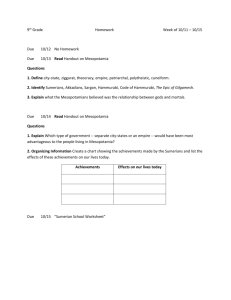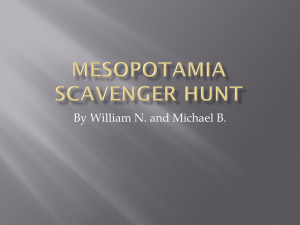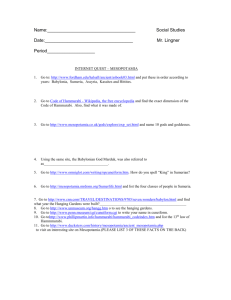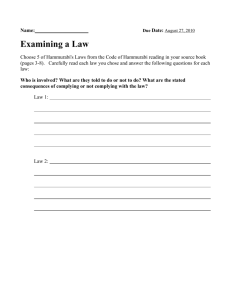Mesopotamia
advertisement
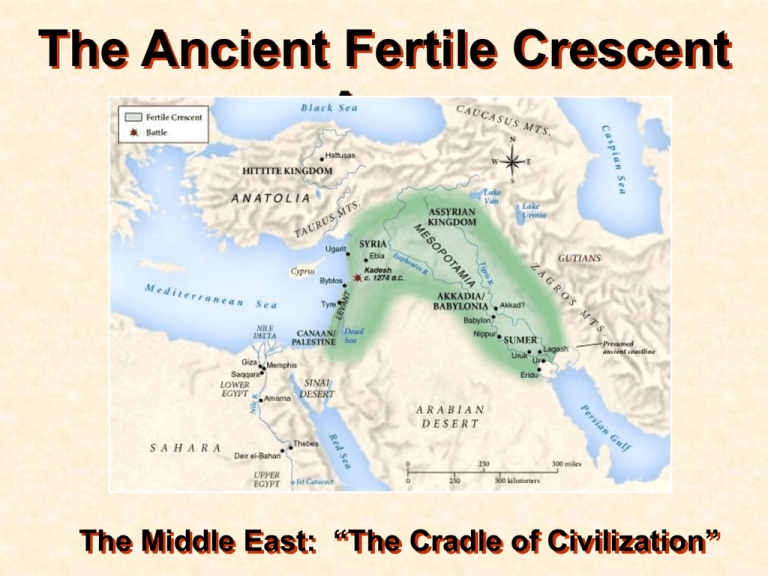
The Ancient Fertile Crescent Area The Middle East: “The Cradle of Civilization” Videos Ancient Mesopotamia 1 Ancient Mesopotamia 2 The Fertile Crescent • A piece of land stretching from eastern Mediterranean sea to the Persian Gulf • Between Tigris & Euphrates Rivers • Soil is rich, great for farming. • Area is shaped like a crescent. • Mesopotamia (Land between the rivers) to the east • Mediterranean section to the west • Stretching from the coast of the Mediterranean Sea in present day Israel to the Persian Gulf, the Fertile Crescent was the birthplace of many early civilizations. • The Tigris and Euphrates Rivers provided ideal conditions for human settlement, with the first civilizations rising in Mesopotamia, or the land between the rivers. Farming • They learned that by planting seeds and plowing their land, they were able to grow crops. The Sumerians learned to domesticate, or tame animals to help them plow their lands. They learned to use irrigation. Irrigation is a system of watering crops to grow more food. The Sumerians also made a very important invention-the wheel. The invention of the wheel made it possible to pull heavy loads. Sumerian Society • Sumeria was composed of several city-states, or nations the size of cities. Walls around each city-state protected the citizens from outside invaders. Farmland was usually outside the city walls, and people would seek protection from the walls of the city when under attack. The Beginnings of Writing Farmers needed to keep records. •The Sumerians were very good farmers. They raised animals such as goats and cows (called livestock). Because they needed to keep records of their livestock, food, and other things, officials began writing in Cuneiform. A system of writing develops. The earliest form of writing dates back to 3300 B.C. People back then would draw "wordpictures" on clay tablets using a pointed instrument called a stylus. These "wordpictures" then developed into wedge-shaped signs. This type of script was called cuneiform (from the Latin word cuneus which means wedge). Who used cuneiform? Not everyone learned to read and write. The ones that were picked by the gods were called scribes. Boys (and select girls) that were chosen to become scribes (professional writers) began to study at the age of 8 at a school. They finished when they were 20 years old. The scribes wrote on clay tablets and used a triangular shaped reed called a stylus to make marks in the clay. The marks represented the tens of thousands of words in their language. Cuneiform Wedge-Shaped Writing Cuneiform Wedge-Shaped Writing Deciphering Cuneiform Click here to write in Cuneiform Cuneiform Cuneiform Sumer, 3200-2350 B.C. Sargon’s Empire, 23502320 B.C. The Amorite invasions, 2100-1900 B.C. The Dynasty of Ur, 2100-2000 B.C. Reign of Hammurabi of Babylon, 1792-1750 B.C. Uruk Uruk: a substantial ceremonial hub by 3500 B.C. Kish was one of the twelve city-states of ancient Sumer civilization. In this city lived the famous and magnificent Akkadian King Sargon, founder of the first Empire in history. Ruins of Kish Grand Palace of Kish Ziggurat of Kish Sargon of Akkad unifies Mesopotamia: world’s first empire, ca. 2240 B.C. Reign of Hammurabi of Babylon, 1792-1750 B.C. Board Game from Ur Metalworking Skills from Ur Gilgamesh A mythical hero. Part man part God. Strong as an ox and built the walls of Uruk. Babylonian Math Babylonian Numbers Ziggurat at Ur This was a large building with a temple at its peak. Social and political organization: • The King: he had military powers. • The Governors: they governed the territories of • The aristocracy: they were priests and traders. • The peasants: the people who work the land. the kingdom. They were generals and judges at the same time. The King The Governors The Aristocracy The Peasantry Hammurabi’s Code Hammurabi’s Code The Law Code of Hammurabi Sumerian Society • The Sumerians were polytheistic, which means they believed in many gods. The Sumerians worshiped their gods at huge temples they called ziggurats. Each ziggurat was dedicated to a specific god, whom the Sumerians believed ruled over their city. When one city was conquered, the invaders would force the conquered people to accept their gods. Most people in the Western Hemisphere today practice monotheism. This means they believe in only one God. Babylonian Empire • Located in modern day Syria • Conquered many parts of old Sumeria (including Babylon) • Hammurabi--created a law code with harsh punishments • Borrowed heavily from Sumerian culture • After Hammurabi’s death Babylon declined Hammurabi • Hammurabi was a Mesopotamian king who recorded a system of laws called the Code of Hammurabi. His 282 laws were engraved in stone and placed in a public location for everyone to see. Some of Hammurabi's laws were based on the principle "An eye for an eye, a tooth for a tooth." This means that whoever commits an injury should be punished in the same manner as that injury. If someone puts out another person's eye, their eye would be put out in return. Hammurabi • Hammurabi's code included what we today call both criminal and civil law. Criminal law is composed of rules that define conduct. One law said, "if a son strikes his father, his hands shall be hewn off." Civil law settles disputes among individuals. Hammurabi's Code states, "if a man builds a house badly, and it falls and kills the owner, the builder is to be killed. If the owner's son was killed, then the builder's son is to be killed." Judaism • To the Israelites, history and religion were closely joined and were recorded in the Torah, the Bible. • The Israelites' beliefs developed into the religion we know today as Judaism. Judaism, still one of the world's major religions, had an important early influence on two later religions, Christianity and Islam. Abraham of Ur, Mesopotamia Abraham of Ur, Mesopotamia • The Hebrews were different from others of their time because they believed in only one God (monotheism). The Hebrew religion began with Abraham, a citizen of the city of Ur. Around 2000BC, God told Abraham to leave his native land. Abraham and his followers wandered through the desert to settle in Canaan. Canaan is on the eastern shore of the Mediterranean Sea on land that is part of the modern nation of Israel. Abraham's decedents are known as Israelites or Jews, and their religious beliefs are known as Judaism. Moses Moses • Many years after Abraham died, his followers traveled to Egypt to escape a famine. At first, the Egyptians treated the Israelites well, but in time the Egyptians enslaved them. According to Hebrew tradition, Moses asked to free his people. God sent ten deadly plagues to Egypt when the Egyptians would not release the Israelites from slavery. God revealed Ten Commandments to Moses. The Ten Commandments are the model for both Jewish and Christian laws. Upon their return to their homeland, the Israelites established a nation they called Israel. • In 586BC, the Babylonians of Mesopotamia destroyed Solomon's temple. The Jews were exiled, or forced from their homes, and made to move to Babylon. This is also called Diaspora (the scattering of Jews). They Jews continued to worship by praying and reading their holy texts. Their holiest book, the Torah, became part of the Old Testament of the Christian Bible. It is the first five books. Activity Hammarubi’s Code of Laws The 10 Commandments Videos God Calls Abraham Prince of Egypt – Let My People Go
